(Note: This story is a continuation of "Duke and Addisons Disease", which you should read prior to this story. For more information about dogs and Addisons Disease, check out this helpful web site.)
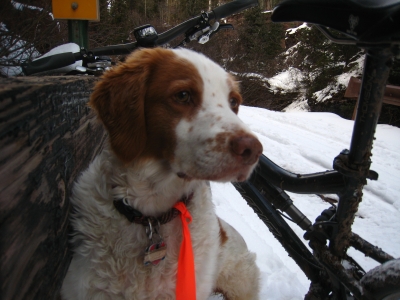
Duke on a ride just before Thanksgiving at Waterfall Creek bridge, Cement Creek Road.
First, to allay your concerns, Duke is doing well. In fact Duke's monetary value has skyrocketed based on the cost of his new medication! We send many thanks to everyone who emailed, called or otherwise inquired about Duke's health. Your kindness and compassion are appreciated. And now back to the story...
Initial Treatment - October 24, 2009
When we last left Duke, he had taken the definitive test for Addisons and received his positive diagnosis. The prognosis was good: we caught it early, admitted him to the Tomichi Pet Care Center ICU and quickly had him on medication. His first dose of Addison-specific treatment medications included Percoten and Prednisone. Two days later Duke felt so much better he upgraded to the regular kennel area. He was happy to see Everest (boarding there also) and we were overjoyed to hear Duke was feeling frisky once again.
Duke and Everest remained at the Tomichi Pet Care kennel while we attended my 31st high school reunion in California. We stayed with Julie Persse and her charming family and their wonderful dogs Fergus and Annie, who assured us Duke would be fine.
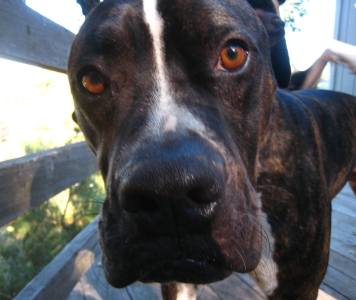
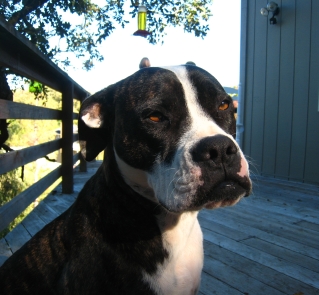
Fergus says, "Duke, look into my eyes... you'll be OK soon!" Annie says, "Come to Danville and play with me!"
Post-Treatment Day 7
Upon our return to Gunnison we picked up Duke just before the vet closed. One comment from Rhonda got our attention, "He sure does drink and pee a lot!" We had never seen this behavior from Duke before. His medical treatment consisted of one tablet of Prednisone twice a day, and a shot of Percorten once a month or so.
The staff instructed us to keep Duke calm for a week: easy walks around the neighborhood, playing in the backyard only, no bike rides, no crazy excitement. Duke wasn't too happy with that regimen, but managed to make it through a week without tearing a pillow to shreds. However, he was eating and drinking like crazy. Peeing every hour. Begging to go out... every... single... hour. Maintaining focus on my work was nearly impossible.
Post-Treatment Day 12
Mrs. Flyingcracker had seen enough firehose peeing and stopped giving Duke Prednisone. Soon afterwards he began eating and drinking less, and thankfully could stay inside for longer periods.
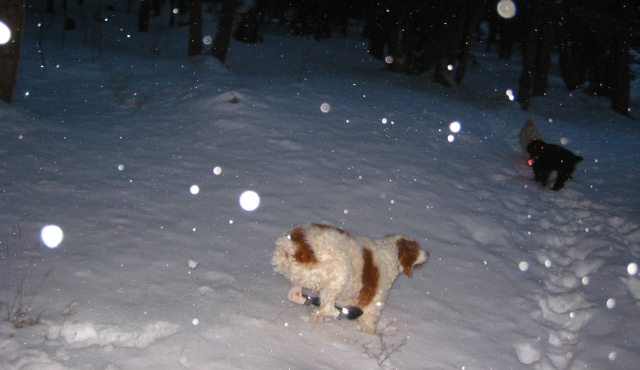
Duke has either mastered advanced yoga or is making great strides in his recovery.
Post-Treatment Day 14
Duke returned to Tomichi Pet Care Center for a checkup. After we explained Duke's eating/drinking/peeing behavior and informed Dr. Jacobson that we had taken Duke off Prednisone she said, "Fine, just put him back on it at a reduced dose when he starts feeling lethargic or not wanting to eat as much." This never happens. In fact he is still drinking and eating a bit more than before getting Addisons. Dr. Jacobson also warned us to monitor his "stress" level, mentioning that Duke may need a bit of Prednisone in high stress situations. The staff took another blood sample to check Duke's mineral levels. The sodium/potassium (NA/K) mineral ratio looked good at 151/4.1 = 37. As we mentioned in the previous story, the desired range is 27 - 40, so everyone was happy with this status.
Now, a few words about stress. Your first thoughts about "stress" might include holidays and/or relatives or being late to an appointment. Our problem was determining what gives dogs stress. Human stress is quite different from canine stress. The vet mentioned having people over for dinner or a party as a possible dog stress inducer. At first we thought that doesn't make sense, Duke loves dinner guests! But on further reflection we realized that whenever Duke gets excited he is getting stressed. And that stress requires energy, provided in part by adrenal gland function to cope with the increased demands of the body. So we entered a cautious period of evaluation, continually monitoring Duke for signs of "stress".
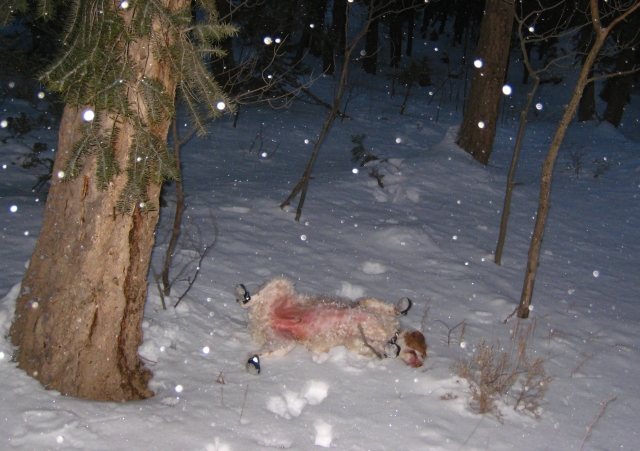
Does this look like a stressed dog?
Post-Treatment Day 26
Diary notes from November 18th:
"We haven't changed a thing. Duke's appetite remains healthy. His energy seems undiminished. Adrenal supplements combined with his rugged mixed breed parentage have made him stronger. Most Addison sufferers need both Percorten and Prednisone. Duke seems to not need cortisol replacement (Prednisone), and that's a blessing. Recently he's ridden with me on the following rides: November 6th (day 14) after the vet appointment we ride 3.2 miles up Cement Creek Road. Duke is fine during and afterwards. November 8th we ride portions of the Woods Walk and Lower Loop, about five miles. No problem. November 11th we do Walrod Gulch and Walrod Cutoff, just over six miles. Again Duke is fine. We put in another twenty miles over the course of several days during Thanksgiving holiday and Duke seems fine."
It has been nearly a month since Duke was first treated for Addisons. He's back at Tomichi Pet Care to see how the initial Percorten dosage has worked over time. A twelve hour fast is a long time for Duke, so I feed him at 1:15 AM before a 1:30 PM checkup. The vet takes a blood sample which shows great results; however his Addison-indicating mineral levels have begun changing for the worse. Sodium is 141, Potassium is 5.5 and the ratio has dropped to 25.6 (desired range = 27 - 40). Nevertheless, the initial dose (1.5 ml of a 25 mg/ml solution) of Percorten lasted around 26 days. Dr. Jacobson decides Duke will get the same dose this time. We're instructed to continue monitoring Duke for issues.
The first day or two after the Percorten shot Duke is sleepy, but quickly regains form. We continue monitoring Duke; all the ins and outs seem normal. He's a bit more clingy than previously and that's OK.
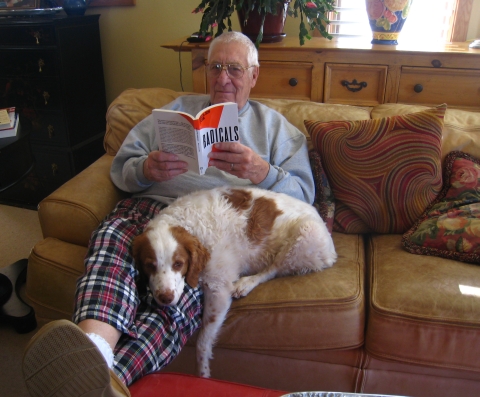
Light reading with Big Bob during Thanksgiving holiday.
Post-Treatment Day 54
Duke returned to the vet for another Percorten shot. This appointment is 28 days after his previous shot (which was 26 days after the first one), and Duke is feeling poorly. Apparently part of the excitement for owners is determining exactly when to give your pet his next shot. In Duke's case twenty-eight days is too long. A day or two earlier he began noticeably slowing down, eating a bit less and walking a bit wobbily. The night before his appointment (no fasting necessary, no blood test needed this time) he threw up bile once again. So we have an answer of sorts: for now, a Percorten shot every 25 days seems to be the ticket for our buddy Duke
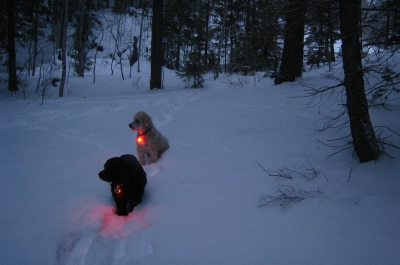
Here he comes...
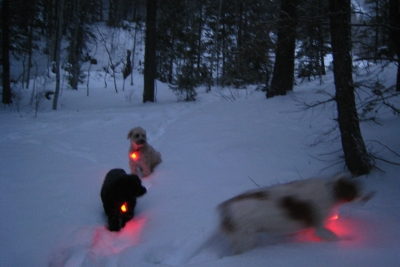
There he goes!
To the Future, and Beyond!
Each Percorten shot cost $117. Every twenty-five days. For the rest of Duke's life. Ouch. However, Duke's a happy and somewhat calmer pooch and we just have to figure out how to keep the costs down.
We're very grateful to Dr. Jacobson and the professional staff at Tomichi Pet Care Center for their superb care and support.
And finally we're especially thankful that Duke is still with us.
Happy New Year!